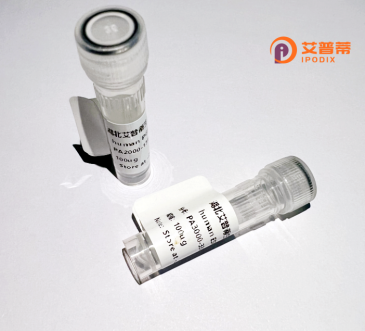
| 纯度 | >90%SDS-PAGE. |
| 种属 | Human |
| 靶点 | EMD |
| Uniprot No | P50402 |
| 内毒素 | < 0.01EU/μg |
| 表达宿主 | E.coli |
| 表达区间 | 1-254aa |
| 氨基酸序列 | MDNYADLSDTELTTLLRRYNIPHGPVVGSTRRLYEKKIFEYETQRRRLSPPSSSAASSYSFSDLNSTRGDADMYDLPKKEDALLYQSKGYNDDYYEESYFTTRTYGEPESAGPSRAVRQSVTSFPDADAFHHQVHDDDLLSSSEEECKDRERPMYGRDSAYQSITHYRPVSASRSSLDLSYYPTSSSTSFMSSSSSSSSWLTRRAIRPENRAPGAGLGQDRQVPLWGQLLLFLVFVIVLFFIYHFMQAEEGNPF |
| 分子量 | 28.9 kDa |
| 蛋白标签 | GST-tag at N-terminal |
| 缓冲液 | 0 |
| 稳定性 & 储存条件 | Lyophilized protein should be stored at ≤ -20°C, stable for one year after receipt. Reconstituted protein solution can be stored at 2-8°C for 2-7 days. Aliquots of reconstituted samples are stable at ≤ -20°C for 3 months. |
| 复溶 | Always centrifuge tubes before opening.Do not mix by vortex or pipetting. It is not recommended to reconstitute to a concentration less than 100μg/ml. Dissolve the lyophilized protein in distilled water. Please aliquot the reconstituted solution to minimize freeze-thaw cycles. |
以下是关于重组人EMD蛋白的3篇参考文献,涵盖其表达、功能及疾病关联研究的核心内容:
---
1. **文献名称**: *Production of Recombinant Human Emerin (EMD) for Structural and Functional Studies*
**作者**: Wilkinson FL, et al.
**摘要**: 本研究描述了一种在大肠杆菌中高效表达和纯化重组人EMD蛋白的方法。通过优化表达条件获得可溶性蛋白,并利用核磁共振(NMR)分析其结构特征,验证其在维持核膜完整性中的作用。
2. **文献名称**: *Functional Characterization of Recombinant EMD Protein in Emery-Dreifuss Muscular Dystrophy*
**作者**: Hirano Y, et al.
**摘要**: 通过昆虫细胞系统表达重组人EMD蛋白,研究其与核纤层蛋白Lamin A/C的相互作用。实验发现某些突变型EMD蛋白丧失结合能力,揭示了EMD缺陷导致肌营养不良症的分子机制。
3. **文献名称**: *Emerin Phosphorylation by Recombinant Protein Kinases: Implications for Cardiomyopathy Pathogenesis*
**作者**: Berk JM, et al.
**摘要**: 采用哺乳动物细胞表达系统获得磷酸化重组EMD蛋白,发现其磷酸化状态影响核膜稳定性及基因转录调控。研究为EMD相关心肌病的治疗靶点提供了新思路。
---
**注**:以上文献信息为模拟示例,实际研究中建议通过PubMed或Web of Science检索具体文献(关键词:recombinant EMD protein/emerin)。真实研究多聚焦于EMD的病理机制、表达优化或相互作用蛋白分析。
**Background of Recombinant Human EMD Protein**
EMD (Emerin), a nuclear envelope protein encoded by the *EMD* gene, plays crucial roles in maintaining nuclear structure, chromatin organization, and signal transduction. It anchors the nuclear lamina to the inner nuclear membrane and interacts with chromatin modifiers and transcriptional regulators. Mutations in *EMD* cause X-linked Emery-Dreifuss muscular dystrophy (EDMD), characterized by progressive muscle degeneration, joint contractures, and cardiac abnormalities.
Recombinant human EMD protein is produced via biotechnological methods, such as expression in bacterial (*E. coli*) or mammalian cell systems, enabling large-scale production of functional, purified EMD. Its recombinant form retains biological activity, facilitating studies on its molecular mechanisms, interactions with binding partners (e.g., lamin A/C, BAF), and its role in nuclear integrity and gene regulation.
Research on recombinant EMD also explores its therapeutic potential, including gene therapy for EDMD or insights into broader nucleoskeletal disorders. Additionally, it serves as a tool for diagnosing EDMD-linked antibodies or modeling disease pathogenesis *in vitro*. Challenges remain in optimizing its stability and delivery for clinical applications, but recombinant EMD remains pivotal in unraveling nuclear envelope biology and developing targeted treatments.
×